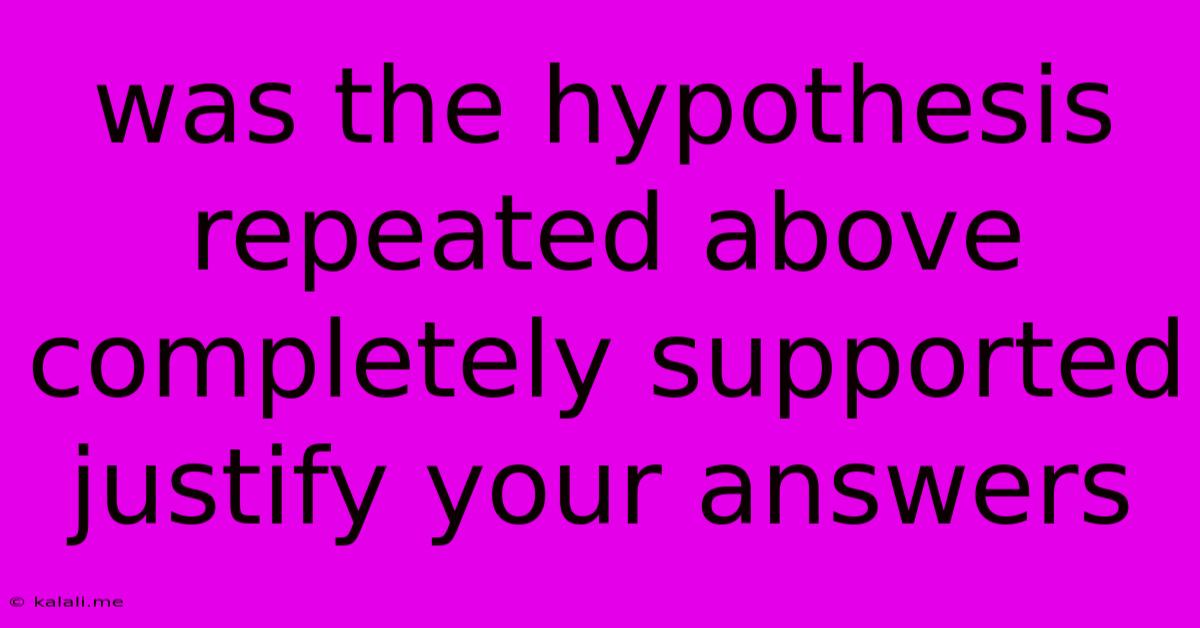Was The Hypothesis Repeated Above Completely Supported Justify Your Answers
Kalali
May 09, 2025 · 2 min read

Table of Contents
Was the Hypothesis Repeated Above Completely Supported? Justifying the Answer
This question requires context. To determine if a hypothesis was completely supported, we need the original hypothesis and the results of the repeated experiment. Since no hypothesis or experimental data was provided, I will offer a framework for answering this question, applicable to any scientific investigation.
Understanding Scientific Hypotheses and Testing
A scientific hypothesis is a testable statement predicting a relationship between variables. A well-formed hypothesis is often framed as an "if-then" statement. For example: "If plants are exposed to more sunlight, then they will grow taller."
To test a hypothesis, scientists design experiments, collect data, and analyze the results. Repeating the experiment (replication) is crucial to ensure the initial results weren't due to chance or experimental error. Complete support for a hypothesis is rare; scientific understanding is usually incremental.
Analyzing Results for Support:
When evaluating whether a repeated experiment supports the original hypothesis, consider the following:
-
Consistency of Results: Do the repeated experiments yield similar results to the original experiment? Significant discrepancies suggest potential problems with the experimental design or methodology. Statistical analysis helps determine the level of agreement between results.
-
Statistical Significance: Did the results reach statistical significance? Statistical tests determine the probability that the observed results are due to chance alone. A statistically significant result suggests the observed effect is likely real and not just random variation.
-
Magnitude of Effect: How strong is the observed effect? Even if a result is statistically significant, a small effect size might not be practically meaningful.
-
Alternative Explanations: Are there alternative explanations for the observed results that could negate or weaken the support for the hypothesis? Good science considers and addresses potential confounding variables.
-
Limitations of the Study: What are the limitations of the experimental design? Were there any factors that could have influenced the results that were not controlled for? Acknowledging limitations is crucial for scientific integrity.
Examples of Levels of Support:
-
Strong Support: The repeated experiment yields similar, statistically significant results, with a large effect size, and few alternative explanations.
-
Partial Support: The repeated experiment yields some support for the hypothesis but with weaker statistical significance, smaller effect sizes, or some alternative explanations that need further investigation.
-
No Support/Refutation: The repeated experiment yields results that contradict the original hypothesis, suggesting the hypothesis needs revision or rejection.
Conclusion:
Without the specific hypothesis and experimental data, a definitive answer to whether the hypothesis was completely supported is impossible. However, the framework provided above offers a systematic approach to analyzing the results of any repeated experiment and determining the level of support for the original hypothesis. Remember that science is a process of continuous refinement, and even strongly supported hypotheses can be refined or modified with further research.
Latest Posts
Latest Posts
-
Cuanto Es 6 Onzas En Gramos
May 10, 2025
-
How Much Is 3 Fl Oz In Cups
May 10, 2025
-
Como Calcular Pies Cuadrados De Un Piso
May 10, 2025
-
What Is 2 Out Of 3
May 10, 2025
-
193 Cm Is How Many Inches
May 10, 2025
Related Post
Thank you for visiting our website which covers about Was The Hypothesis Repeated Above Completely Supported Justify Your Answers . We hope the information provided has been useful to you. Feel free to contact us if you have any questions or need further assistance. See you next time and don't miss to bookmark.